The Intel Broadwell-E Review: Core i7-6950X, i7-6900K, i7-6850K and i7-6800K Tested
by Ian Cutress on May 31, 2016 2:01 AM EST- Posted in
- CPUs
- Intel
- Enterprise
- Prosumer
- X99
- 14nm
- Broadwell-E
- HEDT
Office Performance: Extreme Editions
The dynamics of CPU Turbo modes, both Intel and AMD, can cause concern during environments with a variable threaded workload. There is also an added issue of the motherboard remaining consistent, depending on how the motherboard manufacturer wants to add in their own boosting technologies over the ones that Intel would prefer they used. In order to remain consistent, we implement an OS-level unique high-performance mode on all the CPUs we test which should override any motherboard manufacturer performance mode.
All of our benchmark results can also be found in our benchmark engine, Bench.
Dolphin Benchmark: link
Many emulators are often bound by single thread CPU performance, and general reports tended to suggest that Haswell provided a significant boost to emulator performance. This benchmark runs a Wii program that raytraces a complex 3D scene inside the Dolphin Wii emulator. Performance on this benchmark is a good proxy of the speed of Dolphin CPU emulation, which is an intensive single core task using most aspects of a CPU. Results are given in minutes, where the Wii itself scores 17.53 minutes.
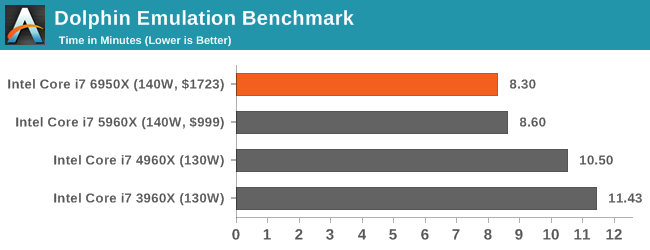
WinRAR 5.0.1: link
Our WinRAR test from 2013 is updated to the latest version of WinRAR at the start of 2014. We compress a set of 2867 files across 320 folders totaling 1.52 GB in size – 95% of these files are small typical website files, and the rest (90% of the size) are small 30 second 720p videos.
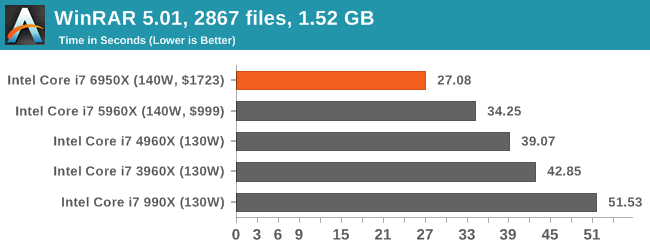
3D Particle Movement
3DPM is a self-penned benchmark, taking basic 3D movement algorithms used in Brownian Motion simulations and testing them for speed. High floating point performance, MHz and IPC wins in the single thread version, whereas the multithread version has to handle the threads and loves more cores.
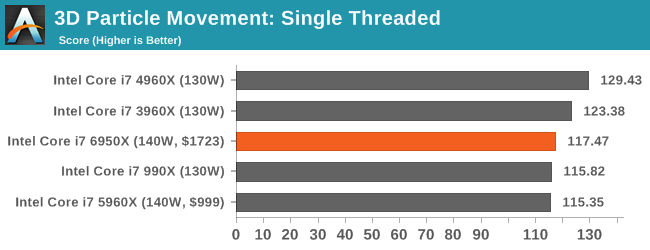
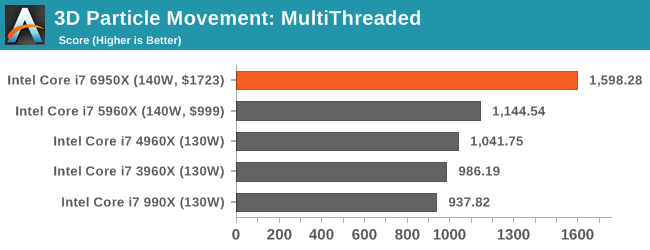
Agisoft Photoscan – 2D to 3D Image Manipulation: link
Agisoft Photoscan creates 3D models from 2D images, a process which is very computationally expensive. The algorithm is split into four distinct phases, and different phases of the model reconstruction require either fast memory, fast IPC, more cores, or even OpenCL compute devices to hand. Agisoft supplied us with a special version of the software to script the process, where we take 50 images of a stately home and convert it into a medium quality model. This benchmark typically takes around 15-20 minutes on a high end PC on the CPU alone, with GPUs reducing the time.
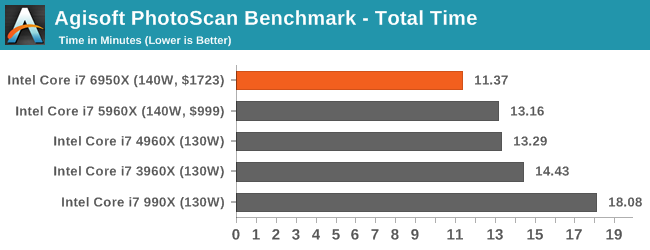
HandBrake v0.9.9: link
For HandBrake, we take two videos (a 2h20 640x266 DVD rip and a 10min double UHD 3840x4320 animation short) and convert them to x264 format in an MP4 container. Results are given in terms of the frames per second processed, and HandBrake uses as many threads as possible.

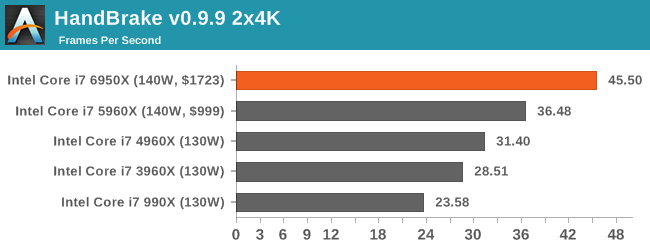










205 Comments
View All Comments
RealLaugh - Tuesday, May 31, 2016 - link
Why are there no 4k resolution benchmarks, did I miss something?Surely the consumer base for this tech are not going to be playing on 1080p?!
Isn't that where the CPUs would start to get ahead of the i5 and i7 products?
Call me out if I'm mistaken!
dannybates - Tuesday, May 31, 2016 - link
You are mistaken.Lower Res = More CPU Dependent, Less GPU Dependent
Higher Res = More GPU Dependent, Less CPU Dependent
Lowering the resolution of a computer game or software program increases the dependency on the CPU. As the resolution decreases, less strain is placed on the graphics card because there are fewer pixels to render, but the strain is then transferred to the CPU. At a lower resolution, the frames per second are limited to the CPU's speed.
RealLaugh - Tuesday, May 31, 2016 - link
ok thanks now I know.adamod - Wednesday, June 1, 2016 - link
i shall purchase a xeon e5 2699 v4 and a GT210.....i was to play crysis at 800x600 but ULTRA!!!Ph0b0s - Tuesday, May 31, 2016 - link
The only thing for gaming might be scaling with more cores. With Directx 12, it makes better use of multi-core CPU's. It would be good for Anandtech to do a story on how Directx 12 scales with more cores, now we can have up to 10. I don't know if there are enough DirectX 12 games to do this yet? If you don't get an benefit for having more that 4 cores then Broadwell-E will not be needed for gaming. If you get a benefit over 4 cores that will be the case for needing Broadwell-E for gaming.jabber - Tuesday, May 31, 2016 - link
Yeah I'm looking forward to playing some DX12 games in 2018 with my DX14 capable GPU. C'mon folks that's how it always works.adamod - Wednesday, June 1, 2016 - link
here is some limited date....it shows ashes and gears at least along with some synthetics:http://www.pcworld.com/article/3039552/hardware/te...
Wardrop - Tuesday, May 31, 2016 - link
Good banner photo! Liking it.r3loaded - Tuesday, May 31, 2016 - link
Yay, price gouging!AMD pls save us.
ochadd - Tuesday, May 31, 2016 - link
Pricing is just prohibitively high imho. I'm still rocking SandyBridge and was hoping the lowest end would basically by a 5820 with 40 lanes unlocked. Would have made a great upgrade. With the pricing I think it's best to wait until the next version of the regular desktop (Kaby Lake?) to pull the trigger.